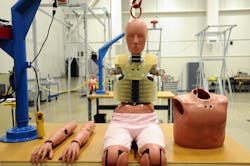New crash test aims to boost light vehicle safety
No doubt you probably heard the breathless general news reports earlier in the week about how only three out of 11 midsize luxury and near-luxury cars evaluated by the Insurance Institute for Highway Safety (IIHS) earned only “good” or “acceptable” crash test ratings.
Indeed, FOUR of those 2012 model high-dollar luxury rides – the Mercedes-Benz C-Class, Lexus IS 250/350, Audi A4 and Lexus ES 350 – earned “poor” ratings from the IIHS, which might make some buyers wonder what they’re getting for their money. (The average sticker price for a new 2012 Mercedes C-Class, for example, hovers around $43,000. Not cheap!)
However, before the hoity-toity set starts flinging their car keys back at their dealers, a word must be said in the defense of the OEMs cited above – for those crash ratings are the result of a new and as-yet not-required test, one that measures what happens in what the IIHS calls a “small overlap frontal crash.”
In this new crash test format, 25% of a car's front end on the driver side strikes a 5-foot-tall rigid barrier at 40 mph. The test is designed to replicate what happens when the front corner of a car collides with another vehicle or an object like a tree or utility pole – clipping said object in a glancing or “offset” manner.
Outside of some automakers' proving grounds, IIHS President Adrian Lund (seen below) noted such a test isn't currently conducted anywhere else in the U.S. or Europe for it’s not something required of OEMs by the various government regulatory agencies that oversee automobile safety."Nearly every new car performs well in other frontal crash tests conducted by the Institute and the federal government, but we still see more than 10,000 deaths in frontal crashes each year,” Lund noted in a statement earlier this week.
“Small overlap crashes are a major source of these fatalities [and] this new test program is based on years of analyzing real-world frontal crashes and then replicating them in our crash test facility to determine how people are being seriously injured and how cars can be designed to protect them better,” he explained. “We think this is the next step in improving frontal crash protection.”
Indeed, the IIHS plans to next assess midsize moderately priced cars, including such models as the Ford Fusion, Honda Accord and Toyota Camry, with its small overlap frontal crash test.
[Want to see how truck makers crash test their products? Take a look at how Volvo does it over in Europe.]
Lund also pointed out that automakers have always been quick to rise to the occasion whenever IIHS added a new evaluation to its vehicle test program, and he expects the small overlap test should be no exception.
“Manufacturers recognize that this crash mode poses a significant risk to their customers and have indicated they plan structural and restraint changes to improve protection in small overlap frontal crashes,” Lund stressed.
He also noted that IIHS “picks on” luxury and near-luxury models first in such testing because they typically get advanced safety features sooner than other vehicles.“Most modern cars have safety cages built to withstand head-on collisions and moderate overlap frontal crashes with little deformation – with crush zones helping manage crash energy to reduce forces on the occupant compartment,” Lund said.
Yet the main “crush-zone” structures of light vehicles are concentrated in the middle 50% percent of the front end. Thus, when a crash involves these structures, the occupant compartment is protected from intrusion so front airbags and safety belts can effectively restrain and protect occupants, he pointed out.
Small overlap crashes, however, are a different story.
“These crashes primarily affect a car's outer edges, which aren't well protected by the crush-zone structures,” Lund explained. “Crash forces go directly into the front wheel, suspension system and firewall. It is not uncommon for the wheel to be forced rearward into the footwell, contributing to even more intrusion in the occupant compartment and resulting in serious leg and foot injuries.”
Thus to provide effective protection in small overlap crashes, the safety cage needs to resist crash forces that aren't tempered by crush-zone structures. Widening these front-end structures also would help, he added.
"These are severe crashes, and our new test reflects that," Lund stressed. "Most automakers design their vehicles to ace our moderate overlap frontal test and NHTSA's [National Highway Traffic Safety Administration] full-width frontal test, but the problem of small overlap crashes hasn't been addressed. We hope our new rating program will change that."


